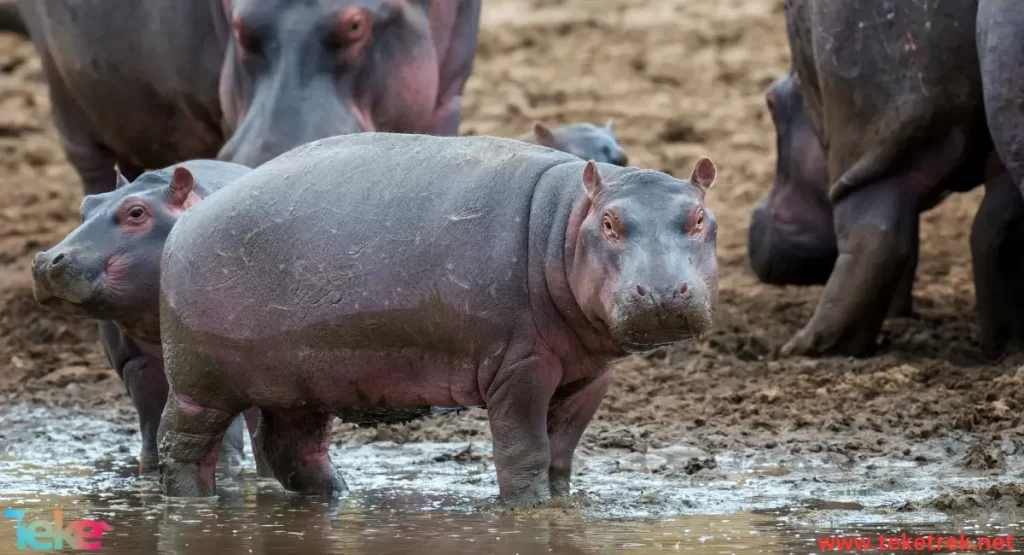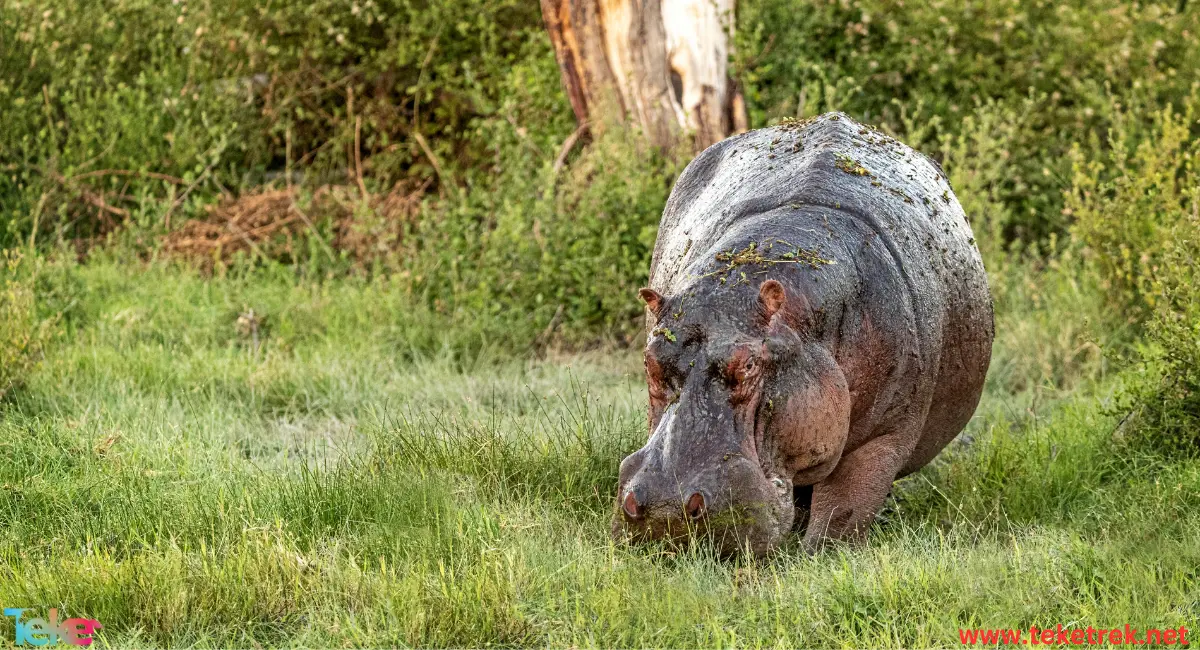The hippopotamus is a mammal that lives in freshwater in South America and Africa. Characterized by its massive body, large head, small ears, and wide eyes, the hippopotamus possesses features aiding its vision underwater. Considered one of the fastest mammals in water, the hippopotamus primarily feeds on plants, grass, and fruits. It faces threats from illegal hunting, habitat loss, and water pollution.
Reason for the name
The hippopotamus scientific is Hippopotamus amphibius.
The Latin term “Hippopotamus” originates from two Latin words: “hippos,” signifying horse, and “potamus,” denoting river.. Hence, the name hippopotamus, as it spends most of its daytime in or near water.
During the night, its groups disperse, while females stay with their young near the water. They follow the shoreline to consume plants for about 5-8 hours before returning to the water before dawn or early in the morning.
Hippo shape
- The hippopotamus resembles a barrel, with short limbs and a massive head.
- An adult individual’s weight ranges between 1100 and 1400 kg, with a height of about 1.5 meters. Its length, excluding the tail, ranges between 4 and 5 meters, while the tail itself does not exceed 50 centimeters in length. Males are larger than females and have four toes, making them even-toed ungulates.
- Each toe of the hippopotamus is furnished with a hoof-shaped nail, while its skin is adorned with gray-colored hair .
- Its body is characterized by a grayish-purple color, with reddish-brown around the eyes. Hair is rare on its body, while its skin layers are very thin.
- It possesses a thick layer of subcutaneous fat that helps it float effortlessly in water. It can stay submerged for up to 5 minutes without breathing, preferring to hide under aquatic plants, leaving only its nostrils, eyes, and ears exposed.
- Its ears, eyes, and nostril openings are located on the top of its head, allowing it to see and breathe while the rest of its body is submerged. It can also close its ears and nostrils to prevent water from entering.
- Its mouth is enormous, about half a meter wide, with huge teeth. Its canines grow up to 50 cm long, while its incisors can reach 40 cm. Its jaws can open at an angle of up to 150 degrees.
The hippopotamus has amazing characteristics and wonderful facts for us to learn together
- Hippopotamuses can live in water for extended periods, up to 16 hours a day.
- Despite their massive size, hippos are known for their ability to swim quickly, reaching speeds of up to 30 miles per hour.
- The hippopotamus is the third-largest land mammal after elephants and white rhinoceroses.
- Hippos cannot swim or float; instead, they find sandy river bottoms and banks to stand on.
- Their eyes are covered with a thick membrane, and their nostrils close, creating a tight waterproof seal.
- In the wild, hippopotamuses typically live between 30 to 40 years, with some individuals living up to 50 years or more.
- Most food foraging activities occur at night since they are nocturnal animals. However, during the heat of the day, they must find ways to protect themselves from the sun’s rays. They spend more time in the water, and mud and water act as a barrier to soothe and regulate their skin temperature.
- Their sensitive skin is the primary reason hippos spend much of their time in the water, away from land.
- Hippos secrete a reddish oily substance called “blood sweat” through their skin. It’s believed to act as a sunscreen, moisturizer, and antibacterial.
- Baby hippos suckle their mothers’ milk during the first year of life.
- Hippos communicate with each other through grunts and groans.
- As hippos move from water to their grazing areas, they create pathways that help other animals know where water sources are located.
- Hippos have a healthy appetite, especially for grass, consuming about 35 kg of grass each night. They can travel up to 10 km in a night to get enough food.

The habitat of the hippopotamus and its living places
- Hippos typically inhabit shallow lakes, rivers, and swamps, where the water is deep enough for them to submerge their entire bodies. Due to the absence of hair covering their skin, hippos must keep it moist to prevent cracking, since they lack sweat glands. Hence, they spend long periods in the water during the day.
- Hippos were once widespread in North Africa, Europe, and some Arab countries but became extinct in those regions.
- Hippos still inhabit lakes and rivers in Uganda, Sudan, northern Congo, Ethiopia, Kenya, and Somalia.
- They also reside in Central, Southern, and Western Africa, including countries like Tanzania and Mozambique.
- Some populations live in entirely separate republics, such as Tanzania and Mozambique.
Species of hippopotamuses
1- Common Hippopotamus:
The common hippopotamus is a semi-aquatic mammal that inhabits Africa south of the Sahara around water bodies such as rivers, lakes, and swamps. The average weight of a male common hippopotamus is 1500 kilograms, slightly larger than the female, whose average weight is 1300 kilograms.
2- Pygmy Hippopotamus:
The pygmy hippopotamus is a small river horse that lives in forests and swamps in West Africa. It is a rare species found only in small parts of Liberia, Sierra Leone, Guinea, and Ivory Coast. Unlike the common hippopotamus, this species does not live in herds but leads a solitary or small group life, consisting of two or three individuals.
Reproduction in hippos
- Hippopotamuses reach sexual maturity between the ages of 6 to 10 years old, but they do not effectively mate during this period. Male hippos typically start mating at around 20 years old, while females start mating between 7 to 12 years old.
- The mating process begins with partner selection. Hippos show clear preferences when it comes to choosing a mate, forming monogamous relationships that can last for long periods.
- Variables like temperature and water levels typically determine the mating season for hippos. During this time, hippos display variable behavior, including vocalizations and movements, to attract potential mates.
- Mating occurs in the water, where the pair grasps parts of their bodies with their mouths and intertwine. The mating process can last anywhere from 30 minutes to an hour.
- The gestation period for females is approximately 240 days. Females can give birth in the water or on land. Birth is a remarkable phenomenon as the calf quickly emerges to the surface for the first time and begins to breathe.


What is the hippopotamus’s food?
- The hippopotamus’s diet mainly consists of aquatic plants and grasses that grow in rivers and lakes. Their food includes aquatic plant leaves such as water lettuce, water grass, and water oak, in addition to fruits, roots, and other aquatic herbs found in freshwater.
- From time to time, their diet might include small fish and other invertebrates found while foraging in the water.
- Hippos consume approximately 36 kilograms of grass every day and cover about 10 kilometers each night to obtain sufficient food. Sometimes, they incorporate fruits they encounter while searching for grass into their diet.
Is the hippopotamus dangerous?
Approaching a hippopotamus should be done with caution, as it may not necessarily pose a threat to humans, but it’s important to exercise care. They are usually peaceful and friendly, but they can become aggressive when defending themselves or their young. If improperly approached or if they feel threatened, they may attack using their powerful teeth and sharp claws. Therefore, it is essential to maintain a safe distance and avoid improper exposure to them in the wild.
In the end, hippopotamus like all creatures, need our help to protect them from extinction. Let’s always be kind to all animals, big and small, and do our part to ensure they will be around for future generations to appreciate and learn from them.






